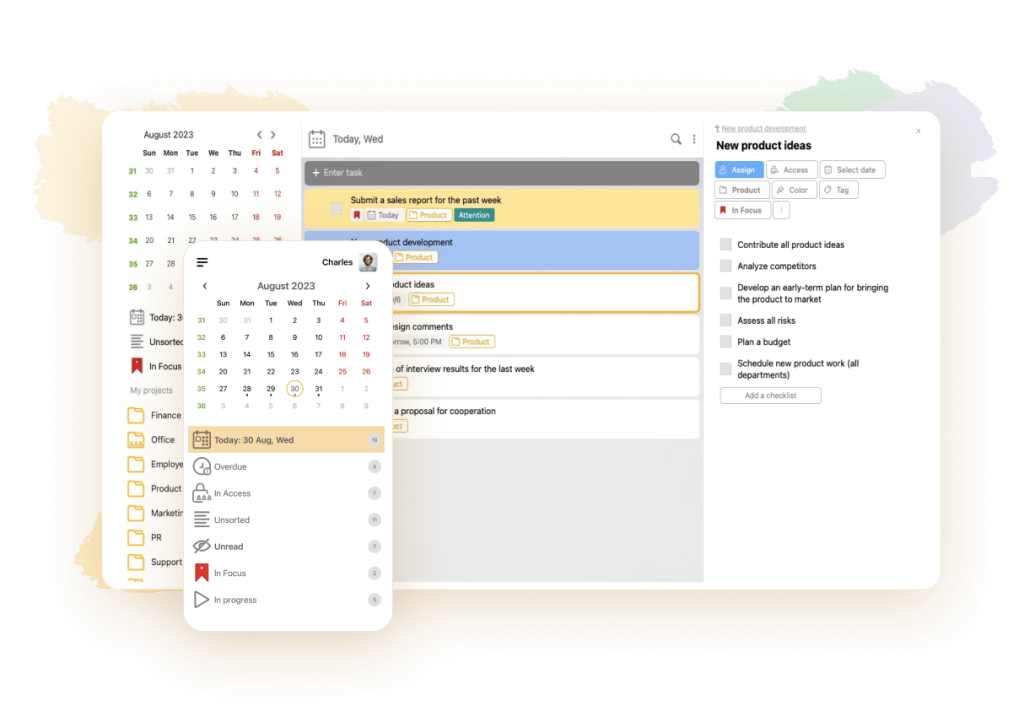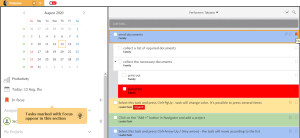The organizational management system

In order to make a company profitable, successful and viable, it is important to manage all its departments competently. This function is performed by the organization’s management system. It includes tools, technologies and methods of influencing resources to obtain the planned result. Management of an enterprise means directing it to the set goal by maximizing the opportunities from the existing resources at its disposal.
Functions and elements of the management system
The management system of an organization is used to develop, make managerial decisions, communicate them to executors and control their execution. Its functions include:
- development of the company’s mission;
- distribution of management and production functions;
- Setting up procedures for employee interaction;
- rational allocation of resources;
- organization of interaction with the external environment;
- implementation of measures aimed at modernizing the company;
- innovation activities;
- company development.
This complexly constructed entity consists of the following elements:
- bodies or management entities (posts or management units);
- communications that ensure the implementation of management decisions;
- a set of methods, tools and technologies regulating employee behavior patterns;
- legal support for governance (in the form of norms, established rules and authorities);
- management process (consisting of communications and management decisions);
- specifications.
Management distinguishes five groups of processes that cover the work of any enterprise. They are the objects of the company’s management. They include:
- Production;
- Marketing;
- Finance;
- Human Resources;
- Accounting and analysis of the company’s business activities.
The organizational structure of management is formed by management bodies. They are united with each other by communication channels. Methods, technologies, tools and procedures that determine the ways of influencing the performers form the management mechanism. The management system is considered organized when its boundaries, composition of elements, structure, interaction scheme and functions of each element are defined.
Principles of functioning of the management system

The management system is based on adherence to the following principles:
- Division and specialization of labor. Employees are given tasks that correspond to their qualifications, experience and knowledge.
- Harmonious combination of centralization and decentralization in management. There are no “pure” structures. Application of a centralized approach with clear subordination to one management center ensures effective coordination of all structural units of the company. Transfer of some powers and responsibilities to lower levels makes management flexible and adaptive to external conditions.
- Scientific and theoretical confirmation. Assumes the use of special techniques and technologies to preserve the company’s sustainability when introducing socio-economic reforms.
- Planning. Aimed at developing major and supporting actions to support the organization’s activities.
- Stable staff composition. Compliance with this principle helps to reduce the cost of hiring, training, adaptation of new employees, and maintain productivity at a constant level.
- Stimulation and motivation of personnel. Selection of competent methods of stimulating employees will positively affect the quality of their work, improve their performance, contributing to increased profits.
- Development of each employee and the company as a whole. This principle is realized through seminars, trainings inside and outside the company. Qualified, educated employees have better efficiency, opening new development prospects for the organization.
- Democratization. Striving for mutual well-being. Employees should be interested in increasing the profitability of the company, as this will lead to an increase in their wages and living standards.
Responsibility for the implementation of the management principles in the system is assigned to the company managers.
Structure of the organizational management system

The management system of an organization consists of managing and managed subsystems. The managing part includes the directorate, managers, information elements and services that support the work of management. Otherwise it is called administrative and management apparatus. Its functions include making managerial decisions based on the information received. The managed part includes units involved in the production process and creation of the final product.
The management system goes through the following stages:
- formation of the general structural scheme of the management apparatus;
- Developing the composition of management departments and organizing the links between them;
- refining and organizing an effective management structure.
When building the management system of an organization, horizontal and vertical links are formed. Horizontal links are established between departments at the same level of management. That is, they are not subordinate to each other. Vertical ones imply subordination of a lower element to a higher one.
Organizational structures are divided into groups:
- with vertical (hierarchical) type of management;
- with horizontal or organic type of control.
Peculiarities of vertical organizational structure
The following conditions must be met for the successful functioning of a company under the vertical (hierarchical) type of management:
- strict subordination of the lower links of the structure to the higher ones;
- competent distribution of responsibilities among employees;
- the prevalence of vertical ties;
- hiring highly skilled workers.
The vertical management structure is based on the pyramid principle. The bottom of the pyramid consists of the lowest positions. The higher the position, the more powers and opportunities its holder has.
Companies with a hierarchical structure are managed by general directors, who are subordinated to their deputies in priority areas. They are followed by middle managers, lower managers and then executives. In organizations with this type of management there are often problems with the execution of assignments because of the long path of information from higher to lower levels. As a result, executives often receive distorted or incomplete information from management.
Advantages of horizontal management structure
This type of management is characterized by flexibility and adaptability to changing external conditions. It implies the rejection of hierarchy with the construction of horizontal links between the participants of the work process. By eliminating bureaucracy in the company’s management structure, the path of orders from the manager to the executors is significantly reduced. This allows to reduce the period of coordination and approval of documents, to fulfill the set tasks promptly and qualitatively.
For the effective existence of such a structure it is important to attract initiative and creative performers. They should interact with each other at a high level. Sometimes it is quite problematic to achieve this, especially if the participants of the structure have opposite views on problem solving.
The more diverse the company’s activities, the more complex the organizational structure of management it has. Based on its type, appropriate management methods are applied.
Methods of organization management

According to the nature of the impact on objects, management methods are:
- Organizational and administrative (direct or indirect). Direct methods of management are expressed in the form of prescriptions indicating to the employee the sequence of work performance. Indirect methods are realized in the form of goals and motivation of employees.
- Economic. These include:
- direct economic calculation performed by the highest levels of government;
- economic or commercial calculation that ensures the profitability of the organization;
- planning, economic and normative indicators and ways to achieve them;
- analysis of business activities, which involves calculating possible risks and considering possible options for the company’s development;
- pricing appropriate to the market situation;
- financing, crediting, aimed at determining the sources of enterprise development;
- economic incentives that take into account the interests of the staff.
- Separately consider economic and mathematical methods, including game theory, mathematical programming and other ways of managing the company’s activities.
- Social and psychological. This is a set of tools affecting relations within the team. These management methods are aimed at maintaining a “healthy” microclimate in the team, creating comfortable working conditions for each employee. They include:
- social development;
- conviction;
- criticism and self-criticism;
- meetings;
- competition within the team;
- corporate customs.
- Self-management. It is characterized by freedom of choice in decision-making and their mandatory execution by all participants in the work process. Issues related to the company’s business activities are resolved at joint meetings.
According to the degree of involvement in the process, management methods are systemic and manual. In systemic processes, direct managerial influence is minimized. Their participants are guided in their work by established rules. They do not need additional instructions or other means of stimulation. The rules are established by laws, regulations or standards developed in the company. Manual management is characterized by the direct participation of the manager in coordinating the actions of subordinates. Without his instructions, performers can not perform any work. This method of management is considered ineffective, since it completely deprives employees of initiative and responsibility for their actions. Therefore, it is resorted to in exceptional cases.
The choice of management methods determines the type of functioning and behavior of workers. It can be:
- Forced. It is characterized by the performance of duties under constant “pressure” from above. It is accompanied by the formation of a sense of dependence and dislike of management.
- Passive. When employees do not show initiative, acting solely on orders from top management.
- Informed. When all team members participate in setting and solving problems.
Models of control systems
Based on the principles and specifics of the company’s activities, models of organization management are developed. Currently, two models are used in practical conditions:
- Goal management;
- Change management.
Goal management implies organizing the company’s activities by setting intermediate goals. This model is used in organizations that do not have a clear statement of ultimate objectives. Therefore, they have to move from one stage to another, which can cause periodic fluctuations from one line of business to another. This model indicates ineffective operation of the company’s management system.
Change management implies that there is one constant goal, on the way to the realization of which intermediate tasks are performed. In this case, all objectives remain unchanged. Only the standards and technologies of management processes are improved.
Effectiveness of LeaderTask application in organization management

To improve the quality of organization of management processes, special electronic applications are used, such as LeaderTask. This is a modern, functional software product designed to solve any issues related to the organization and increase the efficiency of company management.
The following useful features are present in the LeaderTask app:
- Creating assignments for subordinates and controlling their execution.
- Task Delegation.
- Project and individualized planning.
- Organizing Group Collaboration.
- Storage of corporate information with centralized access for employees.
- Effective management of the client base.
- Employee Performance Appraisal.
The program works on all digital platforms. It has all the capabilities to organize company management in the office and remotely. Suitable for individual and team use.
Conclusion
The effectiveness of the company’s management system is evidenced by the balance of centralization and decentralization of power, the ability to adapt to external conditions. The work of such enterprises is not focused on personal needs, but on the needs and interests of the consumer.
Various methods are used to optimize control systems. Examples from practice prove that the best effect in management is achieved by applying an integrated approach together with automation of control processes.
One way to improve the efficiency of company management is to use a theory of constraints approach that does not require a one-time modernization of the system. To do this, one concentrates on individual areas of work. At each of them there is a “weak point” that hinders the fulfillment of tasks. Determine ways to eliminate it. They get rid of it. After solving the identified problem, they find the next “limiter” that hinders the normal development of the company. Thus, they gradually improve the system without resorting to drastic measures.



